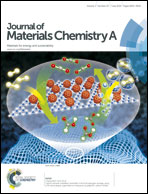A 2-D photonic crystal hydrogel for selective sensing of glucose†
Abstract
A novel 2-D photonic crystal (PC) sensing material for the visual detection of glucose with high selectivity at a physiological ionic strength (150 mM) is developed. A monolayer polystyrene crystalline colloidal array (CCA) is embedded in a phenylboronic acid (PBA) functionalized hydrogel film to diffract light to sensitively report on the hydrogel surface area. This 2-D PC sensor is superior to the previously reported 3-D PC sensors due to its fast preparation and simple detection. The binding of glucose would increase the cross-linking of the hydrogel that could shrink the hydrogel to increase the Debye diffraction ring diameter. At a physiological ionic strength of 150 mM, the 2-D PC sensor exhibits significant sensitivity for glucose across the entire human physiological glucose range. Additionally, the 2-D PC sensor shows high selectivity for glucose rather than other sugars (fructose and galactose). The diffraction color change of the 2-D PC sensor can be observed. For validation, the prepared 2-D PC hydrogel sensor is applied for the sensing of glucose in the artificial tear fluid.


 Please wait while we load your content...
Please wait while we load your content...